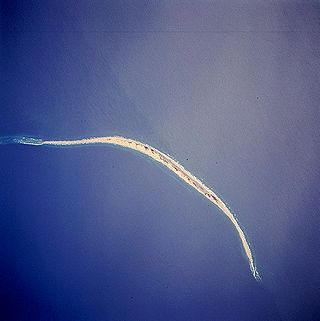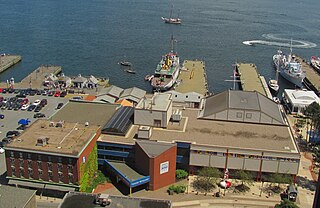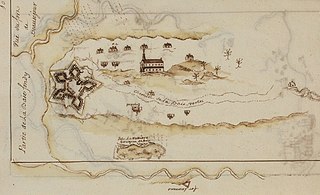
Cape Breton Island is a rugged and irregularly-shaped island on the Atlantic coast of North America and part of the province of Nova Scotia, Canada.

Sable Island is a small Canadian island situated 300 km (190 mi) southeast of Halifax, Nova Scotia, and about 175 km (109 mi) southeast of the closest point of mainland Nova Scotia in the North Atlantic Ocean. The island is staffed year round by three federal government staff, rising during summer months when research projects and tourism increase. Notable for its role in early Canadian history and the Sable Island horse, the island is protected and managed by Parks Canada, which must grant permission prior to any visit. Sable Island is part of District 7 of the Halifax Regional Municipality in Nova Scotia. The island is also a protected National Park Reserve and an Important Bird Area.

Cape Breton Highlands National Park is a Canadian national park on northern Cape Breton Island in Nova Scotia. The park was the first national park in the Atlantic provinces of Canada and covers an area of 948 square kilometres (366 sq mi). It is one of 42 in Canada's system of national parks.

The Maritime Museum of the Atlantic is a maritime museum located in downtown Halifax, Nova Scotia, Canada.

Events from the year 1761 in Canada.

Fort Beauséjour, renamed Fort Cumberland in 1755, is a large, five-bastioned fort on the Isthmus of Chignecto in eastern Canada, a neck of land connecting the present-day province of New Brunswick with that of Nova Scotia. The site was strategically important in Acadia, a French colony that included primarily the Maritimes, the eastern part of Quebec, and northern Maine of the later United States. The fort was built by the French from 1751 to 1752. They surrendered it to the British in 1755 after their defeat in the Battle of Fort Beauséjour, during the Seven Years' War. The British renamed the structure as Fort Cumberland. The fort was strategically important throughout the Anglo-French rivalry of 1749–63, known as the French and Indian Wars by British colonists. Less than a generation later, it was the site of the 1776 Battle of Fort Cumberland, when the British forces repulsed sympathisers of the American Revolution.

Louis de la Corne, Chevalier de la Corne was a Canadian-born military officer and merchant. He was born at Fort Frontenac in what is now Kingston, Ontario, Canada, and began his career in the colonial regular troops as a second ensign in 1722 and was made full ensign five years later. He married in 1728 and began investing heavily in the commerce of the fur trade while continuing his military career. This was a common practice of the time. In the next few years both careers flourished. He received promotions to lieutenant and then captain six years later.

Luc de la Corne was a Canadian-born military officer, merchant, interpreter and politician.
François-Josué de La Corne Dubreuil, was an officer in the colonial regular troops of New France and, as was the norm of the day, involved in family commercial enterprises. He was the son of Jean-Louis de la Corne de Chaptes and a brother of Louis de la Corne, Chevalier de la Corne and Luc de la Corne. His first posting as a commandant of a post was at Fort Kaministiquia, beginning in 1741, where he also engaged in the fur trade.
Arichat is an unincorporated place in the Municipality of the County of Richmond, Nova Scotia, Canada. It is the main village on Isle Madame on the southeastern tip of Cape Breton Island.

Nova Scotia is a province located in Eastern Canada fronting the Atlantic Ocean. One of the Maritime Provinces, Nova Scotia's geography is complex, despite its relatively small size in comparison to other Canadian provinces.

The history of Nova Scotia covers a period from thousands of years ago to the present day. Prior to European colonization, the lands encompassing present-day Nova Scotia were inhabited by the Mi'kmaq people. During the first 150 years of European settlement, the region was claimed by France and a colony formed, primarily made up of Catholic Acadians and Mi'kmaq. This time period involved six wars in which the Mi'kmaq along with the French and some Acadians resisted the British invasion of the region: the French and First Nation Wars, Father Rale's War and Father Le Loutre's War. During Father Le Loutre's War, the capital was moved from Annapolis Royal, Nova Scotia, to the newly established Halifax, Nova Scotia (1749). The warfare ended with the Burying the Hatchet ceremony (1761). After the colonial wars, New England Planters and Foreign Protestants immigrated to Nova Scotia. After the American Revolution, Loyalists immigrated to the colony. During the nineteenth century, Nova Scotia became self-governing in 1848 and joined the Canadian Confederation in 1867.

The Wilkie Sugarloaf Trail is a hiking trail in northern Cape Breton Island in the Canadian province of Nova Scotia. The trail leads to the 411.8 metres (1,351 ft) summit of Wilkie Sugar Loaf in the Cape Breton Highlands.

Little Lorraine is a small village located on the east coast of Cape Breton, Nova Scotia, Canada.

The Naval battle off St. John took place on July 14, 1696, between France and England toward the end of King William's War in the Bay of Fundy off present-day Saint John, New Brunswick. The English ships were sent from Boston to interrupt the supplies being taken by French officer Pierre Le Moyne d'Iberville from Quebec to the capital of Acadia, Fort Nashwaak on the Saint John River. The French ships of war Envieux and Profond captured the English frigate Newport, while the English frigate Sorlings and a provincial tender escaped.
The French ship Chameau or Le Chameau (Camel) was a wooden sailing ship of the French Navy, built in 1717. She was used to transport passengers and supplies to New France, making several trips. Nearing the end of her last voyage, a storm blew her onto some rocks on August 27, 1725. She sank, with the loss of all aboard; estimates range as high as 316 dead. In 1965, Alex Storm and his associates located the wreckage near Chameau Rock, and recovered a treasure of gold and silver pieces.
Aspy Bay is a bay of the Atlantic Ocean near the northern tip of Cape Breton Island, Nova Scotia. Principal features along the bay's coast are the Wilkie Sugar Loaf hill and the Aspy Fault.
Several ships have been named Auguste:












